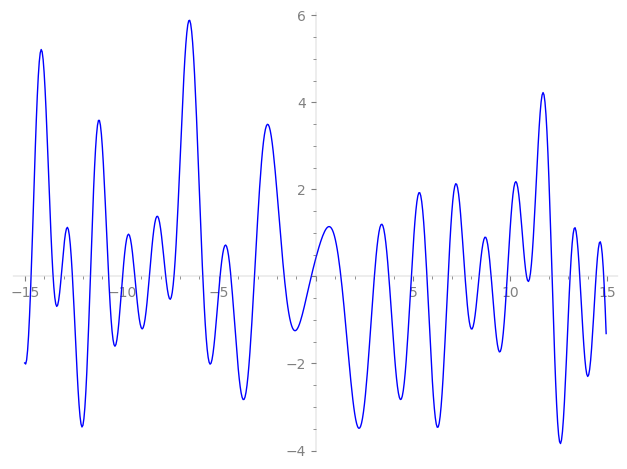| L(s) = 1 | − 0.670·2-s − 1.55·4-s + (−0.712 − 1.23i)5-s + 2.38·8-s + (0.477 + 0.827i)10-s + (−2.46 + 4.27i)11-s + (1.37 − 2.38i)13-s + 1.50·16-s + (0.559 + 0.969i)17-s + (2.00 − 3.47i)19-s + (1.10 + 1.91i)20-s + (1.65 − 2.86i)22-s + (2.71 + 4.70i)23-s + (1.48 − 2.57i)25-s + (−0.923 + 1.59i)26-s + ⋯ |
| L(s) = 1 | − 0.473·2-s − 0.775·4-s + (−0.318 − 0.551i)5-s + 0.841·8-s + (0.151 + 0.261i)10-s + (−0.743 + 1.28i)11-s + (0.381 − 0.661i)13-s + 0.376·16-s + (0.135 + 0.235i)17-s + (0.460 − 0.797i)19-s + (0.247 + 0.427i)20-s + (0.352 − 0.610i)22-s + (0.566 + 0.981i)23-s + (0.296 − 0.514i)25-s + (−0.181 + 0.313i)26-s + ⋯ |
Λ(s)=(=(1323s/2ΓC(s)L(s)(−0.703+0.711i)Λ(2−s)
Λ(s)=(=(1323s/2ΓC(s+1/2)L(s)(−0.703+0.711i)Λ(1−s)
| Degree: |
2 |
| Conductor: |
1323
= 33⋅72
|
| Sign: |
−0.703+0.711i
|
| Analytic conductor: |
10.5642 |
| Root analytic conductor: |
3.25026 |
| Motivic weight: |
1 |
| Rational: |
no |
| Arithmetic: |
yes |
| Character: |
χ1323(226,⋅)
|
| Primitive: |
yes
|
| Self-dual: |
no
|
| Analytic rank: |
0
|
| Selberg data: |
(2, 1323, ( :1/2), −0.703+0.711i)
|
Particular Values
| L(1) |
≈ |
0.4260149444 |
| L(21) |
≈ |
0.4260149444 |
| L(23) |
|
not available |
| L(1) |
|
not available |
L(s)=p∏Fp(p−s)−1 | p | Fp(T) |
|---|
| bad | 3 | 1 |
| 7 | 1 |
| good | 2 | 1+0.670T+2T2 |
| 5 | 1+(0.712+1.23i)T+(−2.5+4.33i)T2 |
| 11 | 1+(2.46−4.27i)T+(−5.5−9.52i)T2 |
| 13 | 1+(−1.37+2.38i)T+(−6.5−11.2i)T2 |
| 17 | 1+(−0.559−0.969i)T+(−8.5+14.7i)T2 |
| 19 | 1+(−2.00+3.47i)T+(−9.5−16.4i)T2 |
| 23 | 1+(−2.71−4.70i)T+(−11.5+19.9i)T2 |
| 29 | 1+(3.40+5.89i)T+(−14.5+25.1i)T2 |
| 31 | 1+2.50T+31T2 |
| 37 | 1+(−0.709+1.22i)T+(−18.5−32.0i)T2 |
| 41 | 1+(−0.124+0.215i)T+(−20.5−35.5i)T2 |
| 43 | 1+(0.498+0.863i)T+(−21.5+37.2i)T2 |
| 47 | 1+9.47T+47T2 |
| 53 | 1+(−0.410−0.710i)T+(−26.5+45.8i)T2 |
| 59 | 1+6.58T+59T2 |
| 61 | 1+0.0752T+61T2 |
| 67 | 1+12.5T+67T2 |
| 71 | 1+0.0804T+71T2 |
| 73 | 1+(5.34+9.25i)T+(−36.5+63.2i)T2 |
| 79 | 1+1.84T+79T2 |
| 83 | 1+(7.23+12.5i)T+(−41.5+71.8i)T2 |
| 89 | 1+(−6.76+11.7i)T+(−44.5−77.0i)T2 |
| 97 | 1+(2.70+4.67i)T+(−48.5+84.0i)T2 |
| show more | |
| show less | |
L(s)=p∏ j=1∏2(1−αj,pp−s)−1
Imaginary part of the first few zeros on the critical line
−9.326933627045154904360722795316, −8.578298131436463693575028774695, −7.73371884616265091431299103727, −7.31079288103065972813610652947, −5.82584337572000479141232726822, −4.93565499795251242310140856933, −4.37912342705926221382120839713, −3.16409609697117601197940798274, −1.63187891132152316254784359013, −0.23956791994584263408497247871,
1.28641097730475574372882863875, 3.01139614429900924605184310798, 3.75673115570171331355476293732, 4.91578174256287537748040823768, 5.71866625690005212665657410139, 6.81096157573518790129136001415, 7.68209673046353272611347637171, 8.405358313918884171910345858901, 9.026597991910496189643622770024, 9.855026110699888530405367452531

